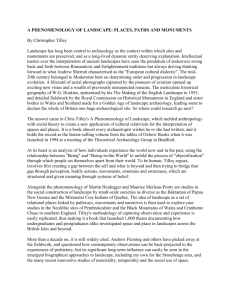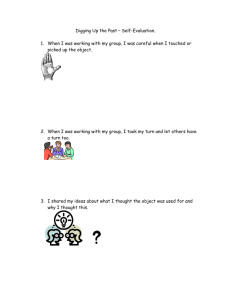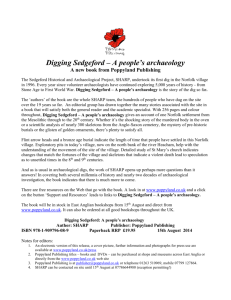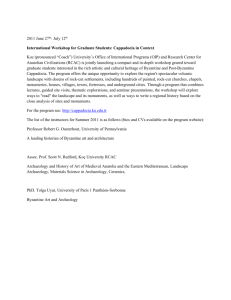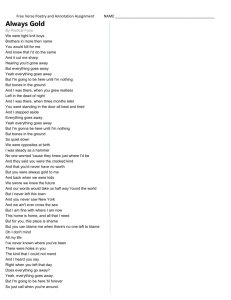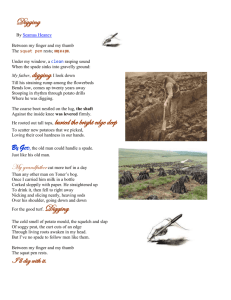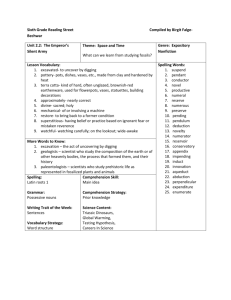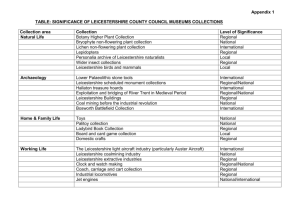Steve Gardner - University of Leicester
advertisement
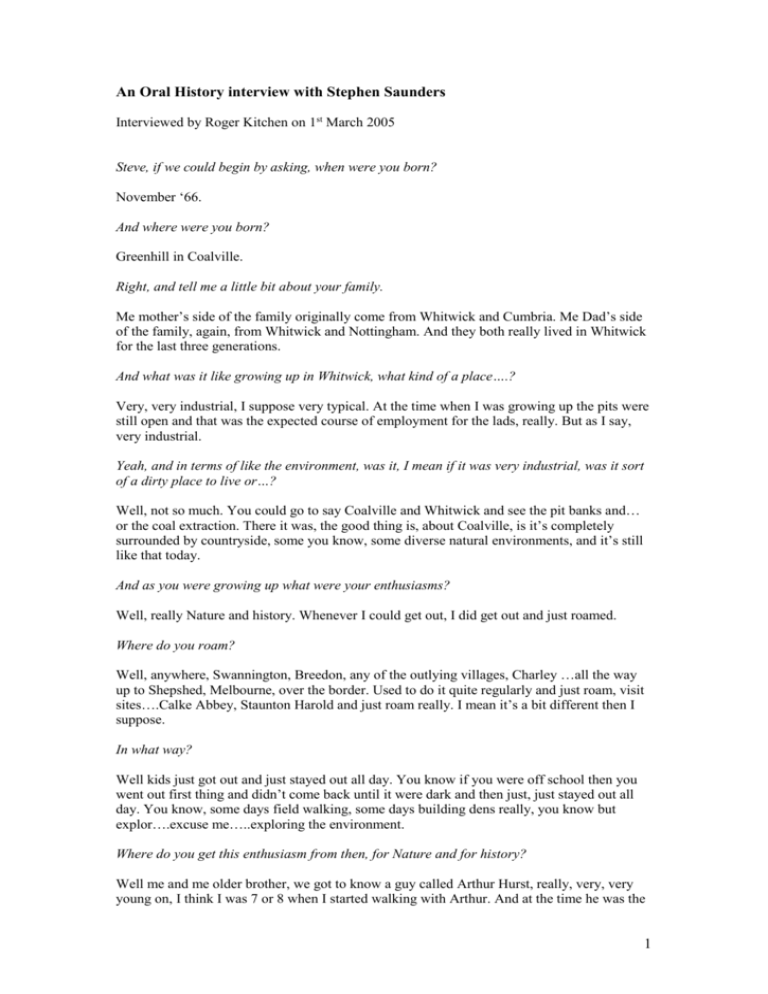
An Oral History interview with Stephen Saunders Interviewed by Roger Kitchen on 1st March 2005 Steve, if we could begin by asking, when were you born? November ‘66. And where were you born? Greenhill in Coalville. Right, and tell me a little bit about your family. Me mother’s side of the family originally come from Whitwick and Cumbria. Me Dad’s side of the family, again, from Whitwick and Nottingham. And they both really lived in Whitwick for the last three generations. And what was it like growing up in Whitwick, what kind of a place….? Very, very industrial, I suppose very typical. At the time when I was growing up the pits were still open and that was the expected course of employment for the lads, really. But as I say, very industrial. Yeah, and in terms of like the environment, was it, I mean if it was very industrial, was it sort of a dirty place to live or…? Well, not so much. You could go to say Coalville and Whitwick and see the pit banks and… or the coal extraction. There it was, the good thing is, about Coalville, is it’s completely surrounded by countryside, some you know, some diverse natural environments, and it’s still like that today. And as you were growing up what were your enthusiasms? Well, really Nature and history. Whenever I could get out, I did get out and just roamed. Where do you roam? Well, anywhere, Swannington, Breedon, any of the outlying villages, Charley …all the way up to Shepshed, Melbourne, over the border. Used to do it quite regularly and just roam, visit sites….Calke Abbey, Staunton Harold and just roam really. I mean it’s a bit different then I suppose. In what way? Well kids just got out and just stayed out all day. You know if you were off school then you went out first thing and didn’t come back until it were dark and then just, just stayed out all day. You know, some days field walking, some days building dens really, you know but explor….excuse me…..exploring the environment. Where do you get this enthusiasm from then, for Nature and for history? Well me and me older brother, we got to know a guy called Arthur Hurst, really, very, very young on, I think I was 7 or 8 when I started walking with Arthur. And at the time he was the 1 local archaeologist. And I got to meet guys like Dennis Baker when I was very young as well, and I just, you know I just liked to hear what they had to say, you know, the fascinating stories about the railways and the Romans you know, and it just went from there. So I mean I’ve just really, just got back in touch with Dennis Baker, you know from over probably 25 years since I last had anything to do with him but….yeah, we were just meeting some of the characters that actually did something in the environment. So, how…I mean you say you met them. What was this when you were roaming and there happened to be this bloke sort of…? I’d ring them up. If I knew they were, if they knew something, like for example Dennis knew something about Swannington railways and I was very much into the railways in Swannington, then I’d ring up and meet him. And then if I was in Swannington on my travels and I thought Dennis was in, then I’d pop in on Dennis. Was this when you were still like a teenager? No, this is younger than this, this is probably 10 years old, 8 or 10 years old. This is really, I mean that’s quite an unusual thing isn’t it, you know where all your mates are round playing football and there you are… 04:39 Well I mean, I mean they’d probably, I’d be out with them as well. You know we, there was 2 or 3 of us that did this, you know, and I mean it wasn’t all positive environmental stuff, you know. We’d make fires like any kid, you know, but at other times you’d be digging bottles. That’s the another thing as well, there’s a big bottle digging fraternity in Whitwick, or there was in the 70’s, and we just jumped in with that. We used to go down, down to Whitwick tip and there’d be some of the lads that are 17, 18 ‘d be digging down there and we’d be a lot younger and we’d be just jump in and dig along with them, you know. And I still see them people today. So I mean that probably as much as meeting people like Arthur is, you know, is as important, because I did carry on bottle digging right into the 90’s, you know, as a pastime. Did those tips…have they been built on now or are they still….or just exploited by…. The…..it depends. The sort of tips, the sort of tips we were digging when we were that young were, were very local farm tips and a lot of them are still there or are dug out. Later on when, especially when you could drive, you’d go to the city tips. A lot of them are as I say dug out, some are still there. The Groby Road in Leicester’s still there. But, they try and do something with them. You can’t build on the tips ‘cause of the ash. You have to extract the ash first before you can build, that’s the….most of them are turned into allotments, things like that, football pitches, you know just, just turfed over. But there’s, you know as a kid we used to go to the small tips, we used to find ‘em, purposely seek ‘em out and dig ‘em. How… what are the telltale signs? Well, normally rubbish is only ever took down hill, and also they’d exploit old pits and quarries and just hollows, you know, gateways between fields… you know, you scratch about and you find that the ash, the black ash and bits of broken glass and pottery and you know you’re onto something, really. I mean, it took up a long time that did as a kid, looking for these tips and digging ‘em. And what were you doing with your finds, were you selling them or just…? 2 Swapping ‘em. Both. You know, keeping ‘em certainly as well. I mean at that stage as a kid it was very small scale and you know, you just got brushed aside by the bigger guys that were doing it. I mean it was just an adult sport back in the 70’s you know, so there was a lot of adults digging as well. But there’s also this fraternity of diggers that are say 5 or 10 years older than me, that you know were 16, 18 when I was digging as an 8 year old, you know, they were digging as well. They sort of drifted out the hobbit as soon as they started leaving Whitwick you know, and the digging stopped, whereas we didn’t, we carried on and dug all over the country, you know, in the bigger scale of things, joined the bigger league in the digging. And you were saying about this Arthur and field walking. What can you remember, you know, what did he sort of teach you as it were? I can remember the cold! That’s about all I can remember. Arthur, Arthur just got your eye and he taught yer how to recognise artefacts you know, and it’s really it’s just a hit and miss process. You know he taught us how to recognise the artefacts and put ‘em into some sort of context in the landscape, really. I mean we were just mules picking up machines and it was Arthur that did all the hard work, all the academic side of it and we just turned up and picked stuff up. But it was all done on a kind of a proper gridded system, was it? Well yes, we’ve lost Arthur’s records. Arthur died in ’84 and there’s very little of his records, there’s so much work he did and there’s very little of his records that remain. You see he was very, he was, how can we put it, he was probably more cavalier than what we are in what we do. He used to work for the electricity board and found hisself a lot of times out in the fields and you know, if he’d seen something he’d just walk in a field, you know, and look or dig, you know, he was very cavalier, more so than what we are now. We have to, there’s a set process now, for getting permission, you know, a desktop assessment of why you want to go in there, what do you want to achieve, you know, there’s much more of that now. They’re trying to bring us more in line with the professionals as I say. 10:01mins But the thing is without the Arthurs of this world people like you wouldn’t have got cottoned onto it presumably… That’s right. Well certainly, certainly, yeah, you know. I mean he is respected, his work is respected, more so for what he found but it’s such a shame that none of his records, very few of his records survive and at the moment I’m relying on, because he did a lot in Ibstock I’m relying on some of the, some of the History Society that worked with Arthur and relying on them to dig stuff up. I’ve come across one, it’s actually over there, one of Arthur’s drawings and there’s another guy’s got some slides of a kiln excavation that he did, you know this is stuff that nobody’s ever seen. It’s lucky that somebody took the time to actually do it. In those days, the, it was, archaeology was being done round here by amateurs then was it, just by enthusiasts? Very few, very few and far between. No,… Leicestershire museum ‘s field walk group didn’t start until ’76. No, we‘ve got archaeological wardens now, heritage wardens as well, so there was very few people doing it. Probably in this part of the county after Arthur, just me and my brother really, more so my brother than me. I drifted off into bottle digging and stuff like that really. But, yeah, very few, it still is very few. There is more, ‘bout a handful of people. 3 But what kind of places were you going to and looking at with him? Was it random or was it… It was wherever Arthur had found something really, or where we had found something. We…for example we found a roman site at Redhill near Swannington, and that’d be the next site you’d walk. You’d have to wait until the field was ready, you know, it runs in seasons field walking. If you’re….if you’re looking, well not so much, no it’s not look, if you’re well planned you can field walk all year, you know, but that only comes after years of you know, meeting landowners, realising when fields are going to be set, who are the landowners that’ll let you walk the fields when they are set, who are the ones that won’t, you know. And you can build up a sort of portfolio of sites, you know and then, I mean, more recently, since the 90’s we’ve been hitting big areas, rather than going to different fields, we’ve been just concentrating on big areas and getting big swathes of the land done, making up bigger reports you know, so we’d look at two or three landowners in one area rather than tripping round visiting all these separate fields. But tell me, coming back to…you said about Swannington and finding some Roman, evidence of Roman stuff. Can you kind of explain to me, if you like from the beginning how that…you know, because presumably you found that through field walking? Well we, we initially found it, I found it with the neighbours, the same age as me and we was….must be 8 or 10, and we were just walking up the footpath back into Swannington, we lived in New Swannington. And it was actually the neighbour who picked up the piece of pot, took it back to me brother and we ID’d it and went up, got permission and walked the field, because it was rough…. And you were about 10? Yeah, well may be younger. And your brother was how old? He was… He was four years older than me. He was….but he was only fourteen and when you say you ID’d it, how did you ID it? How did you know that it was a bit of Roman pot? Well you’d, we’d already done some background work with Arthur, you know. It doesn’t take long to actually recognise the different, you know the different pottery styles, the different you know…. Flint’s harder than pottery, but my nephew now, he’s seven and he can ID flint, you know. It can take an adult six months to do it, you know, but he can do it, you know. It’s not hard. You could train monkeys to field work, honestly you can. The genius is putting it into the bigger context and deciding what it is. Is it a midden scatter, is it an occupation, you know? What’s a midden scatter? Is that just a rubbish heap is it? Well yeah, probably manuring. Somebody actually physically going out and create a manure pile. These piles can be outside the house. They can also be in the field. You have then, have to decide how your finds have got in the field, you know, and then, is there any continuity from different periods you know, running through. 15:16 OK, let’s follow this story. You identify this piece of pottery. 4 Yes, well my brother did. Your brother. And then…you then went back to where it was found and then you... Field walked. Field walked. You were saying about field walking, there being particular times of the year. When is the best time to... The field walk season has changed a bit recently. Normally you get two, generally you get two windows: September to December time. Depends if they let you walk on the crop, if they let the crop come through then you can walk all the way to February. And then you get another window, about March and that’s, you see one’s winter barley, the other one’d be a summer crop, you know, planted a bit later. But because of the weather there’s not many people now plant in March, they try and get the crop in in September, and there’s also Set Aside. You see you can get Set Aside. If you’re lucky they’ll plough it and just leave it ploughed and it’ll stay all year ploughed and get broke down by the rain, you know and you get another opportunity. As I say, if you’re switched on and you do know your location, you know your landowners, you can get walking all year round if you’re lucky, you know. But it’s generally, generally September, October, November and March are you know, are your times. So you go back and you walk this, you field walk. What kind of area are you walking? Well, back then as kids we’d just strip up and down, basically try and do it as systematically as possible. Just within one field? Yes, yes, well I mean you know, I can’t really remember much about the first time down there. I can remember the actual find of the pottery but I can’t remember the actual field walk. I mean we went in later and excavated in the field and… Oh but, so you found more evidence within that field… Oh yes, yeah. I mean enough to say it was a Roman site. You know, that somewhere at Redhill there was a Roman farmstead. And did you then kind of like tell Arthur and others. Yes, oh yes. And was there, were you members of any kind of society? No. At the time there was nothing. As I say, the Leicestershire Museum field walk group was up and running and we did have links, I can remember going to Leicester with my brother and meeting Peter Liddell who’s still the curator of Leicestershire Museum’s field walk group. You know, I can actually remember going and visiting him with finds and this and that….but they, my brother was slightly older, slightly more into it than me and you know, I used to switch off a bit really because I found it boring, I’d rather be out in the field doing it. I were too young to understand the processes they were talking about. But, but yeah, may be Arthur was part of the museum group. I don’t know, we were. 5 So you then identified, talked to Arthur and then what, with the permission of the landowner you just go in there and …dig And walk. No after the walking I meant. After you’ve... Yeah. I mean, I’ve only got a vague memory of me actually being down there and digging but that were possibly in the 80’s, but yeah, my brother did. He did quite a bit, he’d do it on his own you know. So how long a time would there be from the field walking to the digging? Is it years or… May be I don’t know. At that stage probably when my brother was about fourteen, possibly yes. But certainly when we were older, when I was eighteen, he’d ask me, ‘Do you want to come digging and then we’ll go on a site in Ibstock maybe or a you know? But it was…it was if you like, you or anyone else for that matter, acting unilaterally. It wasn’t kind of phone up the county archaeologist and… 19:24 No, no. You know, you do it off your own back. Again, these attitudes have changed and Leicestershire’s a real positive attitude to what you can do. You know, if I was to turn up on a site that’s already on the sites and monuments record that they know that there’s something that’s there, and just dig, then I’d get in trouble, you know. Well it would be frowned on, it’s something you don’t do anyway. If I was to turn up in field anyway and dig, there really is no problem, I mean you know, yes it would be frowned on by the professional…some sectors of the professional community but what can they say? You know, there’s nothing stopping anybody digging anywhere they want really, you know as long as it ain’t a scheduled site. But you, but now before we dig, very, very rarely do we dig now and not have a desktop assessment of what we’re going to do, what we want to achieve you know because at the end of the day it’s a destructive process. You know, but when you’re digging in a ploughed field there’s a destructive process to the archaeology anyway. You know, any sort of qualms about doing it disappear because you know, the site’s getting eroded anyway, you know. But to transfer that into a pasture field on something that’s already on the Sites and Monuments record is different, you know. What’s been your most exciting finds over the years you’ve been involved in it? It’s always somebody else finding it, but certainly, for example in the van at the moment I’ve gorra a saddle quern that we found. I say, my brother spotted it two weeks ago you know, and it’s 5000 years old you know it’s sort of quern stone. There’s a hand axe from Snibstone, an Ashlean (?) hand axe, that’s as old as anything that’s been made in Britain, 500,000 years old. Again found by somebody out walking his dog and we get to see it second hand you know. It’s actually on display… Ashby museum have given us a case in their museum and we display all our flint artefacts from round the district there. That sort of thing. I mean most of my stuff, interesting finds’d probably be glass you know, because of the bottle digging, you know, local rare cods or marble bottles, you know, stuff like that really, rather than archaeological, I mean you know you do find some nice archaeological finds, you do get a bit spoilt you know. Once you go onto a Neolithic or a Early Bronze Age site then you are guaranteed some quality finds, but it has, it does tend to be other people. And I get to see it… I’m the second or third person that gets to see it, you know. 6 But these are people who are just, as you say, walking dogs. They’re not passionate archaeologists… In some ways it’s strange. We do a lot of work at Mt St Bernards, we’ve just finished up there at the monastery, and we did some field walking and the couple that live at St Joseph’s Cottage next to St Joseph’s field, you know, they jumped in the field after we’d gone and next thing I know I were talking to Brother John Paul and he says ‘Oh what do you think this is?’ and it’s a archer’s wrist strap, Neolithic archer’s wrist strap you know, that the guy had found after we’d been in the fields you know. So I mean there is a bit of purpose looking by some people, you know, you do get people saying ‘Oh I were just in… what’s this then? I’ve just been in the field, you know knocking about’. Doesn’t bother me you know, as long as it doesn’t bother the landowner. I’m pretty happy for people to do that you know. It’s community archaeology. So there’s never been any of the…I mean you know, you see it on the…in fact there was a special programme wasn’t there about treasure trove, all this kind of thing, you know, the as….the hoards and all that kind of thing. Plenty of that. Because of my association with the bottle digging fraternity, which is an illegal pastime, you don’t get permission, very rarely get permission to dig where you’re digging. The same sort of people are, do tend to go out with detectors illegally, the nighthawks. And I do know night hawks from Whitwick and Swannington and the Coalville area and they’ve shown me their finds, no questions asked, you know I go and record it and I do do that for a few people, you know. So I do get to see the nighthawk finds and I do get to find out what’s going on you know, where they’re going, as such. You see the portable antiquities I do that now, that’s very much a no questions asked, you know, scenario, as long as you’ve got your national grid reference, you know they don’t ask about the permission and things like that as long as it’s getting recorded, that’s all they’re bothered. But yeah, they do. It seems every man and his dog has got a detector, you know and they think it’s ok to take the dog out and take the detector out. I’m on a footpath, it’s probably a right of way, it still belongs to the landowner. It’s illegal to metal detect on a footpath, any right of way, you know. But it does happen. It’s better now than it’s ever been because of the links with the portable antiquities scheme you know, but it still does happen. What can you tell me then, about you know, from what you’ve discovered in archaeology? Let’s take a rounding stock here. What can you tell us about kind of pre-history and history, what happened around this place? 25:27 Well there’s you know. For a long time north-west Leicestershire, south Derbyshire was, because of things like the Domesday Book, and you know head of population per plough and whatever, they was, you know they was frowned upon as being areas where nobody lived and you know, and the classic is that the soils are too heavy to till you know. We didn’t have any history really until the Industrial Revolution, well at least the back end of the Agricultural Revolution, and none of it’s true really you know. There’s a surprising amount of Stone Age material that comes out everywhere, you know. I can’t, I could probably…the amount of fields - you know count on one hand where there’s never been any flint material come out you know. They were completely all over the district. I don’t think, I don’t think Ibstock is any different to Amesbury really or Avebury in the amount of activity you know. We haven’t got the big monuments but we’ve certainly got people living in the landscape, you know, that’s... And what were they doing? Were they… 7 Farming They were farming. There was no kind of extraction or anything like that? Well there, you know… the possibility is...we don’t have the big stone circles. We do have stones, standing stones and a lot of them were pulled down. This, I think people ought to realise how much this district in different ways has, and South Derbs as well, has contributed to things like the war efforts in the amount of coal and corn and wheat they’ve grown, you know. They really did you know push the boat out and that meant a lot of sacrifice on the landscape, you know. Things like standing stones and barrows, they just got hammered and ploughed out and pulled down. What this was during the Second World War? And the First World War, yeah. And certainly you know, I mean the industrial landscape is earlier, you know right back into the…well I could go as far back into the Medieval period you know, some of the earliest pits in Europe are from north-west Leicestershire, you know 13th century and certainly from the 18th century, a big expansion in coal production, and it does have a detrimental effect on the landscape, you know. And I know farmers, we have worked with farmers that have pulled standing stones down in the last 20 or 30 years, you know. That recently?! Yes, yes. But you know, they’re there, they’ve got to make a profit, they’ve got to live you know. They, you know, they don’t really know what they’re doing as such you know. They look at the landscape different to what we do and you can’t really put ‘em at fault. They’ve got to make a livelihood, you know, and they did it and that’s it. But I mean, you know we were down at Snibstone Grange, fantastic couple Keith and Brenda Woodings who really do let us do what we like on the land, you know, great landowners to work with. And they recently ploughed a field that had been pasture for many years. Loads of humps and bumps in the field and I though great and there was a section of this field that was Set Aside, so it was not going to be ploughed for a year, so we asked if we could excavate some of these humps and bumps and you know see what they were, and we did and they were middens, they were Medieval middens. Masses and masses of pottery in the field, big huge lumps that must’ve been there for years and years and dumped on ‘em and whatever, and really distinct in the landscape. And this was 2002 and I went down, they found a coin hoard and er.. me and Pete Liddell.. Sorry I didn’t catch that.. 29:50 There was a detectress who found a coin hoard on their… a Roman coin hoard on their land, and me and Pete Liddell the county archaeologist, and Wendy Scott the portable antiquities liaison officer went down to pick it up and also to look at this field. Pete was asking me about the amount of medieval pottery in this field. Remember prior to 2002 this field had all these beautiful bumps in it that we thought were house platforms, that were middens. We went back two years later and they were nearly all ploughed out in two years, and... How do they manage to survive so many hundreds of years… It’s just if they don’t get ploughed then they survive. If they get ploughed it’s very… It’s just meadowland.. 8 It’s very, we’ve got a very heavy soil. It takes, you know a lot of deep ploughing. It gets very compact, the sun gets on it, it gets rock hard. It’s no good for crops unless you can break it up, you know get some of the subsoil in there, you know it’s not loamy at all it’s very hard, very fertile soil, you know it does grow, it gets very wet and it’s gets very compacted you know, so they have to heavy plough it really. It takes a lot of breaking up and it’s very detrimental to earth works, you know. I mean, down there really, the deserted Medieval villages’ve been ploughed out basically from the drawings that were drawn 20 years ago, there’s nothing like it now, you know. And as I say, you can literally see over a season, two seasons things disappear. And this is what basically what’s happened in the whole of the county, it’s all clay, sorry this part of the district, it’s all clay soils you know. They just, things just get ploughed out, pulled down. You seem to be kind of, very much a realist here, that in fact you know others would be, you know they’d be out slapping a, slapping a kind of you know scheduled monument ? on it… Doesn’t get you anywhere. You know, especially with the landowners. Processes like the treasure act and you know, actually, sketching the sites are very scary you know, and it could put landowners off you know, and there’s very few of them that are forward thinking. They are there, that’s their livelihoods, I mean they’re battered enough as it is, farming. You know, for me to be getting on their backs and be laying down the law, you know it’s just not… So you’re living with the fact that in a sense the landscape is ever changing really.. It always has been you know, it’s different to what it was a thousand years ago which was different to five thousand years ago. It is, it is evolving you know. It is, it has its, it has its benefits, especially the Industrial landscape. There is a big swathe of land up at the top of Swannington Coleorton, , Pegg’s Green. There’s you know, it’s just completely about coal extraction but it has preserved the landscape before that, because of that and people don’t dare touch it now because one, I ‘d like to think it’s because of what it looks like: bell pits and tramways and mines you know; but it’s not, it’s because it’s deemed as dangerous ground to build on, that’s the only thing that’s saving it really. And you could go up there now with a map that’s 200 years old and there would be not many more houses up there than what’d be on that map and you could actually stand and look at the mills and the dams and the tramways you know, they’re just there in the landscape preserved. And the older landscape, the Medieval landscape’s still there you know, it just needs sorting out from the… And it was because…it’s still there, because underneath there are mine shafts are there? They’re too… Yeah, I mean you know, nobody’d build up there on the scale that they do down in Ibstock or Coalville because of that, you know, but it’s slowly, it’s getting an appreciation of this landscape, certainly by the historical people, you know. I did take James Parry up there, you know, there’s a bit of Coleorton Moor that looks like Grimes Graves, just all bell pits cutting into each other, two, three meters apart, you know.. Where did you say? Clore… Coleorton, Coleorton Moor Coleorton Moor Yeah, Coleorton Moor. And you know it’s just humps and bumps and hollows and everything up there, it’s a fantastic… Some of that’s Medieval, some of it’s Neolithic, there is 9 some standing stones up there, still standing up there, you know. So it has preserved the earlier landscape you know, which is something you don’t get down here, you know, very little, you know. You do get it but not so much ‘cause everything’s flat now, everything’s… 35:02 So the thing is in the evolving landscape, in the changing landscape in a place like this, you see your task then as one of recording and if you like, you know, although it’s going to disappear, making sure that you get as much and learn as much from it, and record it. Yeah. Archaeology is more about discovery, because you,… the sites you look at in archaeology are gone, and they are just fields basically. The… really the preservation side of it now, we do do some preservation, Laud’s Chimney. Law’s? Laud’s. Archbishop Laud. Oh right. It’s one of his rectories in Ibstock. We actually cleaned, recorded and restored the chimney three years ago. Excuse me,… .the Palais at the bottom here, the old cinema in Ibstock, me and Richard Buckley, he’s director of University of Leicester Archaeological Services, we did a photographic survey of the Palais you know, so at least we’ll know what it looks like before it changes. You haven’t got a like a Pres, a Building Preservation Trust in this area? There’s very little. There’s no cohesion in north-west Leicestershire between the people that are interested in history, which is exploited, and get political a lot by all accounts, and we have lost a lot and we are going to lose a lot of historical buildings purely for the fact because the majority of other people think there’s nothing worth saving in this part of the county and the council have a backward view of historical buildings, seriously backward view, and in my lifetime we’ve lost some real gems. The only, the only croft in north-west Leicestershire, you know. It was like a, it was a cobbled croft you know that you find in Shetland, maybe in Ireland. There’s very few of them in the country, never mind in Leicestershire. We lost it probably five years ago, six years ago. Oh but that sounds amazing. I know. I mean I feel as guilty about it because I was aware of it. We were just so busy at the time doing other stuff and I thought well there’s no way they’re gonna knock it down. But in that kind of sense there needs to be, there needs to be a kind of a listing policy. There’s a Conservation Officer at the district council but he’s bullied, incredibly bullied. It’s very political, it’s poor, it’s very poor in north-west Leicestershire, you know, they’ve got an attitude that they take people to court rather than back down to ‘em whereas south Derbs is different. South Derbs has gorra historical society which covers the whole of the district, you know, and this is one thing I’m meeting, I’m meeting another historian, Wednesday night to discuss about pushing it further in north-west Leicestershire you know. I mean for example, they’re building a new college in Coalville. They’re going to knock down the old college and build houses and the old college dates to 1908. You know, it’s as an important a building in the history of Coalville as anywhere else. I can’t think of any other building that has seen as many people go through its doors from the district and yet they’re willing to just knock it 10 down and build houses on it. You know, it’s sacrilege really, you know. Would they knock down the old grammar school in Loughborough, would they knock down the old grammar school in Ashby, you know? There’d be an outcry if they ever did but you know, Coalville doesn’t matter. You know, it’s just a nowhere town you know as such. A lot of people see it as such and I don’t, I can walk up and see the old hustle and bustle 19th century town that had plenty of money. You know, you look at photos of Coalville from the 19th century and it’s like a little Chicago you know. I can still see that, I can see it in the buildings and I think whether its 1710 or 1910, it needs to be preserved, it needs to be you know, looked at you know, and something done to preserve it you know. 39:46 But the thing is, I mean maybe this is, I’ll talk about this after the interview rather than during…I’ve got some ideas for this…but I just want to go back to say, you were saying about back in the kind of Stone Age or whatever, Neolithic Age that there was, it was, people were here for farming. By the time the Romans came,’ cause the Romans you found evidence that Romans were around… Yes Were they still farming? Oh yes And medieval times as well, it was mainly farming? Yes, yes. When…when did the, you know when did the mining start then? The mining, probably Denis Baker is the best guy to talk to, to do with this. The mining really started, evidence of mining is probably the 12th, 13th century, from Lount… Lout? Lount, LOUNT. There was some early I think pillar install mining evidence excavated out when it was the open cast up there. And a lot of tools and wooden artefacts were recovered. It then, it were probably, then it was, it was really patchy, patchy mining, both sides of the border, both in south Derbyshire and in north-west Leicestershire right through to the 16th, 17th century it started to kick off again and definitely the 18th century. You know, and wherever the coal, the coal was first exploited wherever the seams come to the surface which would be Swannington and Coleorton and then just expanded form there really, you know, and… So was this kind of open cast type or just these, what do you call them…bell pits? Bell pits, yeah. Just straight down and round and… That’s right, and then you, you know, but you get bell pits as big as this flat. In peoples’ gardens you can still seem ‘em now, they’re huge craters, you know, and they must have had a massive, massive, you know, derrick above ‘em, structure, baskets that probably take four or five people you know. With pillar and stall mining then there’d, gone are the days of the bell as such, and there’d be the shaft and the, you know and the stalls you know, and they’d 11 just leave the pillars of coal in to hold it up really, you know. And it must be a honeycomb. You can look at the aerial photographs, and we’ve been caught out with this thinking that some of the mining excavations are other archaeological features in the landscape. And you can go and get mapping and just see it’s a lattice pattern, under places like Swannington, or a chessboard pattern, you know where you can actually see it in aerial photographs, you know it’s incredible. And in those, in the 16th century and all that kind of thing, they were just using coal as fuel were they, just… Yeah, yeah. I mean somewhere, I think south Derbyshire had a reputation for ornaments made out of coal. And you had the bauble industry in both Challiston, south Derbs and in Thringston in Whitwick, in north-west Leics, that’s where they were actually shaping alabaster, you know making baubles, that was a sort of mini industry that they had. I think the coal, a lot of coal used to go to Leicester really, you know and London. There’s… used to actually pack, pack the coal, clean it and pack it for London, you know so it didn’t get the peoples’ hands dirty, I mean it’s so, so strange but they used to do that, you know. Used to purposely cut it and pack it, so it would be… And transported by cart? I suppose, yeah, a pannier made probably the canal by then, you know the canal. But you had the tramways anyway in certain parts of the district you know, … That was really to get it, the tramways were really just to get it to the main road were they? Get it to somewhere where they could, yeah, export it. But this is, it’s fascinating to hear that the…they’d do anything not to pay any turnpike costs, you know and it was one of the, the mining operators’d bang a route through to get the coal onto the road and then the turnpiker people’d put a gate there so then the miners’d just change the route again. I mean a guy called Wilkins, in the 18th century, it’s estimated he made 4 million pound out of the coal in Swannington. That’s his money, not our money. His money, it’s an incredible fortune. And what year was that? This is in the 18, no1780s, probably earlier actually, sorry probably earlier, probably 1750s, 1760s. 45:01 That is incredible! It is. That’s Bill Gates sort of earnings really, you know. And it gives you an idea of how much coal came out of, out of Swannington and this is, this is you know, pre-railway, you know, very sort of on the borders with the canals but certainly more pannier and packhorse transportation you know, and tramway where they could. Definitely the tramway getting it off the site onto the roads. You know, you can understand why the turnpike guys were chasing ‘em. What do…Cor, this is absolutely fascinating, this is what’s wonderful about this, it’s such a surprise I just, you know. Yeah. 12 I mean the other thing is, looking at, you know, as you say the landscape’s been evolving in some places ok because of what’s underneath it, it’s likely to stay there. What difference do you thing the National Forest is going to make to all this? I think it’s apositive really, because this district has gave itself for coal now and put itself on the line in agriculture, you know and it’s about time some other district did. you know, there’s still plenty of millions of tonnes of coal to be exploited. At the moment we have two open casts in northwest Leicestershire alone and they want to rip another one out in Ravenstone, just between this village and the next village, you know, and we don’t want it. I can’t see any point if, you know, this district’s served and done its time, done its time admirably you know, for the cause whatever that cause was, the Industrial Revolution, the expansion of industry, and certainly the two World Wars. You know, why should we do it again, and the National Forest is showing really that we can be something else, you know it’s about time that people did realise that we have the beauty as well as the black. You know, we’ve got some stunning landscapes, both historically and naturally. They should be looked at, should be exploited really, as much as the coal was and the clay was, you know. We’ve done our bit, you know, let somebody else you know, have the open casts and the clay extraction, you know. This is a time for a change and I think the National Forest can bring it, you know. From an archaeological point of view it’s not so good because trees destroy archaeology as much as any other process you know, so I mean at the moment we want to get, the purpose of the group now is to get into the process where the tender scheme, the people planting the trees are aware that there’s somebody who’s willing to look at the land priority of the trees going in. You have a similar role, ‘cause you know cause where I live in Milton Keynes there’s a hell of a lot of development and archaeology is very much a part of all of that and in a sense…but you haven’t had the same kind of developments that there’ve been in Milton Keynes, but the National Forest will be that in a sense won’t it? The trees will be rather than estates… That’s right, yeah. But the National Forest, you know feel more obligated to do something about it. We’ve had plenty of house building round here and at the moment there is no consultation agreement between our district council who are building the houses, or getting the planning applications to build the houses, and the county council who supply the archaeological service, you know, So therefore, the planning applications don’t officially get looked at. You know this is a nationwide, it’s also a national, international archaeological agreements. I can quote the Policy Planning Guidance 16 in Britain and also the Valetta Convention which is an international convention. This council breaks these international conventions because of their actions, you know, so yes, you’re lucky in Milton Keynes your archaeology is looked at prior to any kind of house building. I mean you don’t get that up here, you know, we’re the only district in the county that hasn’t got the agreement, you know so it’s not a bed of roses, you know. And the National Forest you know, to their credit, do encourage it. But we want to be at the forefront, we don’t want to be driving along the road and seeing valuable tree planted sites, you know, fields that we’ve worked in, which has happened, planted up and the grass has grown that long that we can’t do anything with ‘em. 50:00 But it’s not built in then to the tender scheme that there, you know, if there is archaeology there is an amount paid to get…. The onus is on the owner, the landowner, not the National Forest, which is a government body, is wrong really, it should be the National Forest. But we’re at a point now where, I’ve done the letter, I’ve met Hugh Williams who does the tender scheme, only through a lot of feet stamping I must say, but we have got there and hopefully we’ll be more involved with the actual tender scheme people. We field walked the very first tender scheme in the National Forest, that’s how long we’ve been involved with the National Forest, we’ve done several 13 since, you know. We’re supporting the land shapes as much as we can you know, trying to encourage other people. Our payback is the fact that we get involved more so in the tender schemes, you know, and there is more, a more positive put on the history and the archaeological environment and not just the natural environment, you know. But as I say Rhiannon’s an archaeologist you know, and she’s completely aware of what we want to do you know, and why we want to do it, really. On a...I just want to end on a personal note really and that is, you’ve had this enthusiasm from a very young child and you’re obviously still full of that enthusiasm, yet you’re a builder, you’re not an archaeologist. Why didn’t you end up, if you like, becoming a professional archaeologist? I missed it when I were younger and I didn’t go back to college until I was 35, so you know…and I’ve realised now that academia is…it’s ok to be academic in your own study, but as for an actual, any kind of academic qualification more than what I’ve got, it’d just be a lot of work for no benefit. Because I know the people at Leicester University now, you know, and I know worra want to do and how to do it really. I mean I’m looking at an extension to the land shapes really, being more involved with that, you know, more than anything. I missed the boat really, you know I should have done it when I were younger but nowadays the universities is just degree factories and that’s, unfortunately archaeology is just another ‘ology. You’re, as you were saying to begin with in a sense you’re lucky that this particular county council has got a very positive attitude to ‘amateur’, but I mean, good God, I mean amateur means ‘for the love of’, professional means ‘paid’. I mean you must know a hell of a lot, you must know as much as if not more than a lot of people who are called professionals because they are paid to do it. Yeah the…I mean, yes certainly. You bump into a lot of archaeologists that are just, haven’t done anything since they finished uni, did very little practical work since they finished uni, you know and really you have to show ‘em the ropes again, you know. You do miss out because archaeology is continually moving, the techniques and attitude, so you are really still backwater, you know and do sometimes unfairly get treated that way, you know, but the attitude, even from the profess… I mean I can only talk about Leicester University here. They’re the real professionals that we ever deal with, you know, them and the County Museum Service. And they’re great, they are so pro plus to the amateur. You know, they actively encourage, actually they teach you know, archaeological technique to the amateur to the best of their abilities, you know. I can only talk about Leicestershire and Leicestershire is head and shoulders above the rest of the country really. There’s very few match up, you know. Situation in Northamptonshire is dire. There’s no County Museum Service, the archaeologist, archaeology is really looked after by a backbone of amateurs and non-paid professionals, Rhiannon being one of ‘em. You know, so it’s a really poor situation in Northamptonshire, whereas Leicestershire is just miles ahead. 55:07 Ok, final, final question, this might be a very difficult one for someone who’s, if you like, spent so much time out there in the landscape. If there’s one, if you’ve got one favourite place… It’s becoming…I think it’d have to be the Charnwood environ. As I say, if we’re looking at sites, I don’t think I can pinpoint, there’s some that are very similar. There certainly is an environment, a square mile say, it’d have be, have to be Cademan, Cademan Hill, Charnwood Mount St Bernards, the top of the volcanic rock up on the, up at Charnwood itself in the forest. It’s got everything, it’s got the Neolithic, it’s got the Bronze Age, it’s got moot sites, meeting places, it’s got the monastery you know, designed by Pugin. And it just sits in this 14 rocky treed environment, you know which, ten steps forward you can see massive panoramic views over the Trent Valley, all the way into Nottinghamshire and Derbyshire, and ten steps back and you’re into this hidden bowl, nobody knows is there unless you actually go up there, you know, which is a sacred landscape littered with beaker burials and barrows, and then ten steps the other way you’re looking down onto the Hinkley-Coalville plateau and Bardon Hill, you know and it’s just an incredible landscape. Sort of scratch, people have scratched livings on and lived up there you know, for thousands of years and you can see different, different generations of people being up there you know, and understanding that there is somewhere, this is a real link with the past, you know. The Neolithic were there, up there polishing stone axes. As I say, the Catholic Church, in you know the…Ambrose Delisle (?) putting up his whacky monuments in the woods so you can discover ‘em, you know and then eventually the monastery being built up there. It completely fits in with a wild environment that is nevertheless used. There’s a Roman municipium up there somewhere, massive coin hoard, was ploughed up by the monks back in the 19th century, there’s some’at big going up there, off up there in the Roman times, a villa or something, you know, yet to be found, rediscovered, you know it’s all, it’s an incredible environment. And I can go up there now to a rock shelter, you know, that we think was first used in the Mesolithic hunter-gatherer period you know, and there’s fires there now, and beer cans, and ok you can look at it as being a loutish litter. You can also look at the site being reused 6000, 10,000, 20,000 years after it was first used you know. And these magical knotted and twisted oaks up there, miniature, miniature trees that have been battered for hundreds of years, you know, still there growing out of the rocks. I can understand people for generations going and look at this landscape, so….that’s…. Well that is fantastic! I’ve taken James up there. He’s been up there once but we were in the fog, so we were going back up today ‘cause it’s worth the view, you know. Brilliant. Well thank you so much. It’s all right, no worries. 59:26 15

